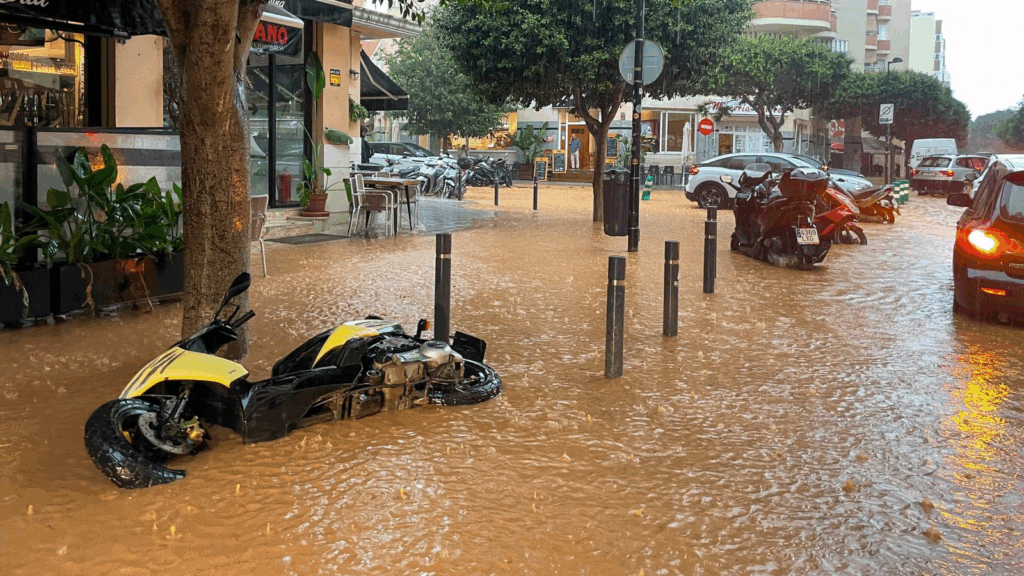
Ibiza, Spain — September 30, 2025
A severe storm system dumped extraordinary volumes of rain over Ibiza on Tuesday, triggering what local authorities and emergency services describe as an historic flooding event. The deluge left neighbourhoods submerged, roads impassable, dozens of people rescued or stranded, and emergency units — including the Military Emergencies Unit (UME) — mobilised to assist local crews.
The scale of the rainfall (what’s verified)
Official and media reports show the rainfall totals were exceptionally high in a short period. Measurements published by local and international outlets indicate:
- Some weather stations recorded over 200 litres per square metre in only a few hours, with Ibiza Town totals reported in the low-to-mid 200s of millimetres over 24 hours in certain gauges. Ibiza Airport recorded very large accumulations as well. These figures place the event among the most intense rainfall episodes the island has experienced in recent records.
Why this matters: such concentrated volumes overwhelm urban drainage and natural channels, turning streets into fast-moving torrents and causing rapid, dangerous flooding in low-lying areas.
Emergency response: military and civil protection deployed
Regional authorities escalated their response as the situation unfolded. The Balearic Government requested support from national emergency resources and activated flood protocols; the Military Emergencies Unit (UME) and reinforcements from neighbouring islands were deployed to support rescue, evacuation and infrastructure protection operations. Civil protection services and firefighters carried out numerous rescues and damage-control actions across the island.
Human impact: evacuations, stranded people and damage
Emergency services reported multiple incidents of people trapped in vehicles, elevators and flooded garages; hotels and some residential blocks were evacuated as a precaution in the most affected zones. Hospitals and health centres recorded service interruptions due to water ingress in non-critical areas, and local authorities moved to secure vulnerable facilities. While many people were rescued or reached safety, the full human impact — including the final tally of injured or displaced people — remained under assessment at the time of reporting.
Transport and infrastructure: ports, airport and roads disrupted
The storm produced wide transport disruption across Ibiza:
- Road networks leading to and from Ibiza Town were cut or heavily congested by standing water and debris; several main access routes — including the airport approach roads — were closed for safety reasons.
- The port area experienced serious flooding that complicated ferry operations; at least one arriving vessel encountered extreme water flow while docking and passenger disembarkation was made difficult.
- Airport terminals suffered water intrusion in some areas, leading to delays and diversions for certain flights while staff managed leaks and passenger safety.
Public transport services were suspended in multiple lines as crews prioritised emergency response and safety.
Schools, public warnings and immediate precautions
Authorities advised parents not to attempt to collect children from schools until conditions improved; many afternoon classes were suspended while pupils remained under supervision at their centres. Civil protection issued mass alerts urging residents to stay indoors, avoid unnecessary travel, move to upper floors if water entered homes, and follow official channels for safety updates.
Weather alerts and cause of the storm
Meteorological services identified the system as the remnants of a broader Atlantic cyclone (reported in coverage as related to ex-hurricane Gabrielle) interacting with a moist Mediterranean flow, producing extreme rainfall over the eastern Iberian coast and the Balearic Islands. AEMET and emergency services issued red and orange warnings for the Balearics during the peak period of the storm; forecasts warned of continued risk of heavy showers and flash flooding until the system moved away.
What has been independently cross-checked
To avoid inaccuracies, the following points have been cross-checked across multiple reputable outlets and official statements:
- Rain totals and heavy localized accumulations — confirmed by meteorological totals and reporting from multiple agencies and outlets.
- UME deployment and activation of flood protocols — confirmed by regional government and local reporting.
- Widespread transport disruption (ports, airport, roads) — reported by local and international media with on-the-ground updates.
- Evacuations and people assisted — corroborated by emergency service bulletins and local coverage; exact final counts still being compiled.
What remains uncertain or under verification
Some details circulating on social media and in early eyewitness accounts require careful confirmation before being reported as fact. Items to treat cautiously until official figures are released include:
- Precise final counts of injured persons and the total number of evacuated residents or tourists.
- Exact rainfall ranking for the entire historical record of Ibiza (some reports say “the highest ever”; meteorological agencies are still validating station-by-station records).
- Localised infrastructure damage assessments (structural inspections and insurance claims are ongoing).
We will update these figures only when confirmed by official emergency services or national meteorological data releases.
Immediate priorities and next steps
Authorities and emergency managers are focused on:
- Search, rescue and welfare: locating and assisting anyone still trapped or displaced, and ensuring shelters and care for affected residents and visitors.
- Restoring access: reopening key roads and transit corridors and verifying the safety of bridges and underpasses.
- Water removal and sanitation: pumping out inundated public areas and assessing contamination risks to water and sewer systems.
- Damage assessment: rapid technical inspections of hospitals, schools and critical infrastructure to prioritise repairs and safety measures.
Longer term, local and regional governments will need to accelerate resilience planning — from improved drainage to updated emergency protocols — to reduce the impact of similar extreme events in the future.
How residents and visitors can stay safe (practical guidance)
- Follow official civil protection alerts and local radio/TV updates.
- Avoid driving or walking through floodwater; just 30 cm of moving water can sweep a person off their feet, and deeper water can carry vehicles away.
- Move to higher ground or upper floors if water enters buildings; do not use elevators in flooded buildings.
- If you encounter people in immediate danger, contact local emergency services and provide precise location details.








